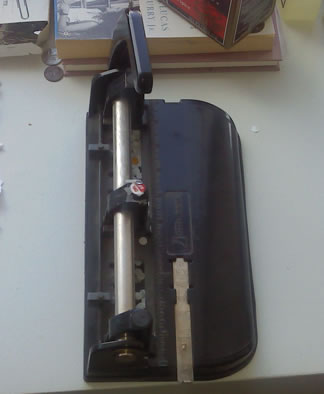

Our discussion of the Don Norman chapter and, in particular, his neat concepts of "Visibility, Affordances, Mappings", give us a pretty effective tool for beginning to articulate why are particular interface to some particular artifact works so well...or fails so miserably. I like to call the use of this approach a VAM analysis.
What we want to do in order to present a careful, coherent, formal analysis report follows the essential structure of what we did as informal verbal review in lecture. Here is an outline:
The following give a couple of brief examples to give you a clear idea of where you're heading. These are relatively simple artifacts with few controls and quite simple (1-1) mappings. Whatever you choose as your artifacts, you'll want to use the same careful methodical style, considering every aspect of the artifact from the VAM perspective.


(Note: not a super-interesting example; just for illustration of the VAM technique)
The doors on the main, north entrance to the Engineering building are an example of a well-functioning interface. I've never seen a single person have trouble with these doors, probably to the point that most people couldn't tell you exactly what type of doors are there --- they are just that invisibly good-functioning. Like all doors, the goals of this artifact relevant to the end-user are really very straightforward: allow for fast, flowing access to the building. (Locking, heat retention, security, etc. are also important, but not centrally so to 98% of end-users who just want to pass through; these functions are not evaluated). Through presenting strong visibility, well-designed affordances, and obvious mappings, this artifacts represents a fine example of good design.
Visibility: How well does this artifact make visible all major components relevant to function, and the interconnections between them? In terms of visibility, this artifact is excellent: all parts of the door mechanism are visible and open for inspections: panels, hinges, handles...you can see everything and how it's connected and functions together. The visibility is enhanced by the fact that the door is transparent, meaning that you can see things (e.g., hinge mechanisms) on the other side of the door from where you are standing, even if the door is closed. This visibility results in excellent feedback potential: you can see all of the parts clearly, so you can clearly see what happens when you manipulate any controls you try.
Affordances: To what extent are potential controls immediately apparent? To what extent do these controls suggest how to manipulate them? The affordances are excellent as well. On the outside, the door handles immediately present themselves as key controls: they are right at hand height, are of the perfect hand shape for grabbing, including nice smooth edges. The are further highlighted on the door with a darker silver color and backing plate. Because the hooped shape of the handles strongly communicates the affordance of "grabbing onto", the most obvious way to manipulate them is well communicated: you just pull. Other possible manipulations (e.g. twisting the handle), are not actively encouraged: there are no indications (seams, pivot points) that the handle might do this. On the inside, the handles are, in facts, large bars extending across the whole door. Again they are highlighted as key (and in fact only) controls by slightly different coloring, as well as being placed in perfect position to manipulate from the center of an average person's mass. By presenting a large, flat smooth, surface, the obvious suggestion for manipulation is pushing on in a horizontal direction. There is no misleading suggestion for twisting or lifting (e.g. texture pads somewhere, false hinge points); pushing is very plainly communicated. Moreover, the pushing surface is displaced somewhat towards the center, encouraging pushing in the right horizontal location to swing the doors. The hinges are not easily mistakable as controls, as their shape and placement doesn't really suggest that you're supposed to touch or grasp them, being small and hard to grasp, and without any texturing or other cues that would encourage one to grasp/touch them.
Mappings: How obvious is the connection between controls and achieving the functional goals communicated? Or discoverable? The mappings for this door are not explicitly indicated (labels), but are excellent nonetheless; the high visibility and clear (and minimalist) control options make discovering the mappings possible almost always on the first try. Given that there is just one key user goal here, and just one apparent set of controls, the mapping is an easy 1-to-1 mapping: users intuitively try the one visible control as they try to achieve the one desired action. Because of the excellent affordances, they usually manipulate the control exactly in the necessary manner (pushing or pulling); the high visibilty of the artifact makes it possible to monitor/confirm progress towards the goal continuously and obviously, i.e., as they try the control, they can watch to see how the control affects the artifact and see progress (or not) towards their goal of opening the door. When a mapping mistake does happen (e.g. pull instead of push, or vice versa, or any other mis-manipulation), the high visibility makes it simple for the user to briefly analyze the door structure more carefully, leading to a corrected mapping and success.
In sum, the doors to the engineering building are a well though-out design. Even though doors are not at all complicated artifacts, they can be surprisingly problematic (just check out the inet cafe doors!) due to failure to provide the many little affordances that make proper and successful utilization of an artifact completely seamless.
Here is another one:

My desktop holepuncher is an example of device of slightly higher complexity, that has a fairly good interface, despite there being no printed instructions beyond some minimal labeling to the direct the user. The users goals for using this device are simple: get 2 or 3 holes punched at the proper position/alignment on the side of a piece of paper.
Visibility: How well does this artifact make visible all major components relevant to function, and the interconnections between them? The visibility is not perfect, but still quite good: the user may easily observe the various components of the device -- base, handle, slider bar, and other elements of the complete system with a little bit of inspection. The punches themselves are somewhat hidden in metal sleeves but are/become visible as controls are manipulated. The interconnections of the major pieces are largely visible, though small bits (e.g. the gearing connecting handle to rotating punch rod) are concealed in a housing. The key point here is that, even if you can't see the *exact* connection, you can easily see how the pieces are linked and affect/move each other.
Affordances: To what extent are potential controls immediately apparent? To what extent do these controls suggest how to manipulate them? The affordances are reasonable as well: there is a large handle-like protuberance that just begs to be grasped by a human-sized hand...smooth, and perfecly hand-sized. It is oriented on a lever arm around a pivot; one surface is rounded slightly, suggesting both that the palm of the hand should go there, and that this is likely the "top" of the handle, i.e., that one should push down on this side. The slider for controling placement of the material to be punched is emphasized as a control by chroming, making it stand out starkly from the black body, and a tab at the end it perfect in side and shape to be pinched onto by fingers. It's flat shape, and placement at the end of the slider bar suggests that you can grasp it and promotes pulling/pushing from side to side (rather than, say, up and down); it is recessed and marked with number line, suggesting adjustability and the capability for numerically accurate repeatability. The knob on the center pier is highlighted with a red "on/off", and is knurled to suggest grasping and turning; it's clear that this is a control of some sort. Finally, the slots under the piers and the bed-like affordance of the base naturally suggest this might be an interesting place to stick your piece of paper; they are too small to put fingers in and nothing else suggest that they are controls that get moved of manipulated.
Mappings: How obvious is the connection between controls and achieving the functional goals communicated? Or discoverable? The mappings, namely figuring out how these controls should be manipulated to achieve the goal of punching holes in the proper place on the paper, are non-trivial but remain fairly straightforward because they are essentially 1-1: each control is used to change just one function or characteristic of the outcome. The main user goal of getting some holes punched in paper can be easily discovered by manipulating the control in just the way the affordances suggest, and using the great visibility of the device to discover the mapping towards the end-user goal.. Stick on a piece of paper, then manipulate controls. The main handle is purposefully large and obvious attracting immediate attention and signaling that it is the most important control. The good visibility lets you see the whole mechanism at work. This not only lets you very quickly figure out the mapping for your main goal (punching some hole) but is also critical for discovering secondary functions of adjusting hole position and number. The mappings to achieve the more "advanced" functions of the device, i.e. controlling whether two or three holes are punched and adjusting hole(s) position are bit more challenging to figure out. The slider is easiest: it's pretty obvious that just taking advantage of the affordance of the slider tab will move it...which will change the positioning of the paper within the device.. The "2 or 3" hole control is harder, but the user has eliminated other possible controls, leaving the knob on the central pier. The hint of the "on/off" label on the knob, and experimenting with twisting the knob to both positions soon yields the correct mapping. The visibility of the device helps here too: just looking into the slot while manipulating lever and knob show the hole punchers (2 or three) moving up and down in the slot. In sum, the holepuncher's interface is reasonably well-designed for a "dumb" device; it's hard to see how this moderately complex set of functions could be made more accessible to users.
In sum, the Acco Model #350 is a popular and proven hole punch device for good reason. Although the design is many many years old, it's high quality have made this product popular for generations. The combination of high visibility, clear affordances, easy 1-1 mappings between each control and a key function all work together to overcome the challenge of making the mappings easily discoverable without prior instruction.